

|
Equinox Project | Friday, February 13, 2009 I spent the morning on a variety of smallish job, all part of an ongoing yet shrinking punch list of miscellany. Some of these were not noteworthy, just loose ends of a non-specific nature. One of the more noteworthy chores, using the term loosely, was to install a scoop strainer over the engine intake. For this, I chose a version that would make for more convenient cleaning and servicing down the line. While most of these external strainers mount directly to the hull with screws, meaning that each time one wants to service or clean inside the fitting the entire thing must be removed and then rebedded, this particular strainer featured a mounting flange, which I attached to the hull with #8 x 1/2" bronze machine screws set into tapped holes and thoroughly bedded. The mounting flange, permanently attached to the hull, accepted the main portion of the strainer, which fit over the flange with six small machine screws tapped into the flange. For now, I installed the strainer portion mainly to prevent the sealant, which had squeezed through the holes, from curing and blocking the threads. Later, I planned to remove the strainer and paint the area within. |
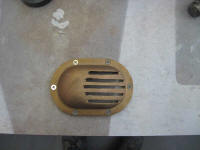
 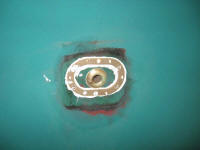
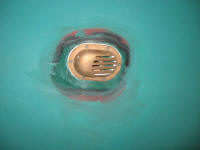 |
|
Now that I'd installed the access plates inside the anchor well, there was no reason to wait any longer to reinstall the anchor well hatch. Down on the bench, I cleaned and polished the hatch as I had with the other portions of the deck, and then installed the hinges on the hatch itself before securing the other side of the hinges to the deck. |
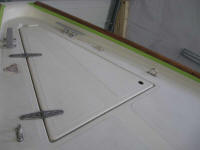 |
|
Next, I prepared to varnish the exterior wood trim. I sanded all the caprails and handrails with 220 grit to smooth out any remaining inconsistencies around the bungs, and then used a variety of grits to clean up and smooth a small wooden trim ring beneath the opening hatch in the saloon, which I had not addressed before this stage. After vacuuming up the dust and wiping all the wood with paint thinner, I masked off around the wood as needed, tacked off, and applied a coat of varnish everywhere. I also began the varnish buildup on the ash tiller, which I'd stripped earlier but had yet to begin varnishing. |
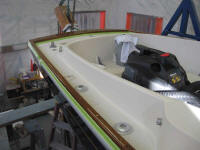

 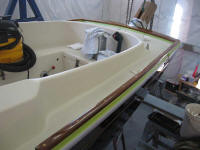 |
|